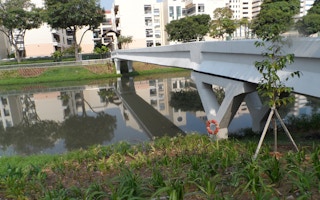A long-term initiative to transform Singapore’s water assets beyond their drainage and water supply functions into vibrant new community spaces is taking place today amid a backdrop of rapid urbanisation and increased rainfall patterns due to climate change.
To continue reading, subscribe to Eco‑Business.
There's something for everyone. We offer a range of subscription plans.
- Access our stories and receive our Insights Weekly newsletter with the free EB Member plan.
- Unlock unlimited access to our content and archive with EB Circle.
- Publish your content with EB Premium.
It’s a backdrop which means much greater volumes of storm water are being generated from impermeable surfaces and roofs.
As a catchment becomes urbanised, it creates more paved and concrete surfaces that prevent rainfall being absorbed and infiltrated into the ground as part of the natural water cycle.
In addition, rain water starts to enter the drainage network much faster from concrete and road surfaces than from landscaped and vegetated areas. These two factors combine with increasing rainfall intensities to create flash flooding.
“
The ABC Waters programme looks to break down the traditional ‘concrete channel approach’ to create a naturalised waterway that is more resilient to the dangers of flash flooding and water quality issues in a dense urban environment, caused by uncertain weather conditions and increased urbanisation.
Flash floods caused by heavy rainfall have already prompted changes in the regulations on how water is managed in Singapore.
From January last year, all new industrial, commercial, institutional and residential developments with a site area greater than 2,000m² have been required to control the peak runoff discharged from the site to what would be the natural undeveloped condition, up to a return period of 10 years and for various storm durations.
Alongside all this is the challenge of providing clean, fresh water for Singapore’s growing urban population.
The Marina Reservoir, created in 2008 from the damming of the mouth of the Kallang Basin, plays an important role in this – it was designed to provide 10 per cent of the island’s water needs.
As Singapore’s newest catchment, the Marina Reservoir is its largest and also most urbanised, so the effects of increased rainfall and urbanisation are most keenly felt here and on its tributary drains more than anywhere else on the island.
The Kallang River is the longest river in Singapore and flows for 10 kilometres through the centre of the island from the Lower Peirce Reservoir to Marina Reservoir.
In the 1960s and 1970s, concrete drains and canals, including the Kallang River along Bishan Park, were created to alleviate widespread flooding.
However, it became clear that this approach was not capable of coping with increased rainfall patterns and the impact of continued urbanisation. New initiatives and ideas were needed to protect Singapore.
And as a result the Active, Beautiful, Clean Waters (ABC Waters) Programme was launched in 2006 by Public Utilities Board (PUB), the national agency which manages Singapore’s water supply and drainage.
The ABC Waters programme looks to break down the traditional ‘concrete channel approach’ to create a naturalised waterway that is more resilient to the dangers of flash flooding and water quality issues in a dense urban environment, caused by uncertain weather conditions and increased urbanisation.
Our work for the ABC programme is helping to regenerate and re-naturalise that concrete channel - recreating the natural processes that will improve water quality, reduce stormwater flows and improve biodiversity.
For example, rain gardens are used along the course of the Kallang to capture and treat runoff from surrounding areas before it enters the river.
Our aim is to reduce peak storm water flows into the drainage system to prevent urban flooding downstream.
The work is also focusing on improving water quality, reducing the need for intensive treatment when it reaches the reservoir by filtering the stormwater through a series of rain gardens.
The soil media in these rain gardens is designed to remove organic bacteria and break down chemicals found in roads and car parks, while the plants selected will take up nutrients like nitrates and phosphates to prevent algae blooms and oxygen starvation - common problems faced by reservoirs
There’s another welcome spin off from all this work. These projects also help get people closer to water so they can enjoy recreational activities along the riverbank.
For example, we have been working with local schools on educational projects and the adoption of rain gardens and swales for future maintenance.
We make sure that water is managed throughout the treatment, from source to conveyance and retention.
The issue of dealing with storm water is becoming increasingly important in Singapore and will remain so in the future. It is a problem that has to be dealt with.
Richard Outhwaite is Director of Web Earth, an environmental and sustainability consultancy that specialises in sustainable building design, water resources and carbon management.











